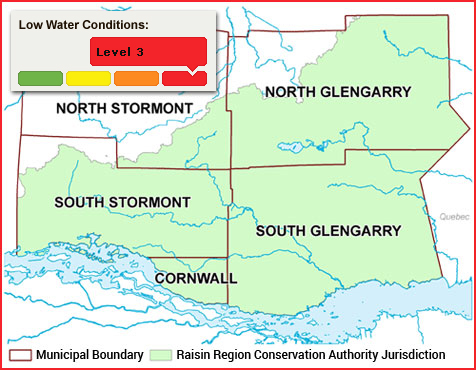Current Status: Level 3
RRCA Water Response Team Declares Low Water Level 3 Status for its Jurisdiction
Thursday, October 30, 2025 (3:00 PM)

The RRCA’s Water Response Team has declared a Low Water Level 3 status for the RRCA’s watershed jurisdiction on October 30, 2025. A Level 3 can be declared when flows are less than 30 percent of their normal summer low flow and/or precipitation has been less than 40 percent of average. There can also be potential for economic harm to water users and/or significant harm to the ecosystem.
The RRCA monitors stream flows and precipitation data at gauges strategically placed throughout its jurisdiction in the City of Cornwall and Townships of South Glengarry, North Glengarry, South Stormont, and North Stormont. While data records on October 30 indicated that overall precipitation in October (i.e., 52.2 mm) was approximately half the historical normal average normal amount for October (i.e., 87.7 mm), monthly flows are currently below 30 percent of normal. Water Response Team members – local representatives from municipal and provincial governments and other interest-holders – also shared documented reports of private residential wells having gone dry and observations of dried-up streams not typically dry this time of year.
The RRCA jurisdiction first entered a Low Water status Level 1 this year on August 12, moving to Level 2 on September 18. Residents and businesses are now asked to reduce their water consumption as much as possible, whether they are connected to municipal water supplies or to a private well. Residents are encouraged to check their municipality’s website to be aware of any municipal water conservation or fire bylaws in effect.
The RRCA will continue to monitor stream flows and precipitation as part of the Ontario Low Water Response Program and will provide updates as conditions change. For more information visit rrca.on.ca/LowWater or contact (613) 938-3611 or info@rrca.on.ca.
Water User Feedback Form
Are you being impacted by low water (i.e., is your well dry)? Please help the RRCA gauge local impacts of low water by filling out our water user feedback form.
Water Conservation Tips
- Repair any leaks in your home (e.g. taps and toilets)
- Reduce non-essential water usage such as lawn watering or car washing
- Only wash full loads of laundry or dishes
- Install a low consumption showerhead
- For farmers: monitor your irrigation systems for leaks, and consider irrigating closer to the evening to reduce evaporation loss
Resources for Residents with Private Wells
- Types of wells
- What to do when your well goes dry (and when water returns)
- Never put water into your well – this could damage the well or contaminate groundwater
- Consider bulk water haulage services that provide water and storage tank rentals
- Learn about groundwater, private water supplies and the different types of private rural water wells: ontario.ca/page/private-rural-water-supplies
- Tips for managing your well in times of water shortage: ontario.ca/page/managing-your-water-well-times-water-shortage
- Contact the Ontario Ministry of the Environment, Conservation and Parks - Water Well Help Desk (Phone: 1-888-396-9355 Email: wellshelpdesk@ontario.ca
- Contact a licensed well contractor if you need to do work on your well: ontario.ca/page/find-licenced-well-contractors
- Well Disinfection Tool: Provides an easy way to calculate the amount of cholorine produced needed to disinfect a well
- Private wells: Drinking water safety during and after a power outage
Water Conservation Fact Sheets
- Conserving Water Inside your Home
- Conserving Water Outside your Home
- Conserving Water on your Farm
- Managing your Well
- Water Smart – Protecting Water from Source to Tap
About Low Water Response and the RRCA
The Ministry of Natural Resources and Forestry (MNRF) manages water use during a drought. Ontario’s Low Water Response Program ensures provincial and local authorities are prepared in the event of low water conditions. The Raisin Region Conservation Authority assists the ministry by assessing local watershed conditions and notifying residents.
The Raisin Region Conservation Authority monitors precipitation and water levels throughout Cornwall; South Glengarry; and large portions of North Glengarry and South Stormont.
About Low Water Notices

Normal
Flows are in the normal range and precipitation accumulation has been close to average.

Level 1
Flows are less than 70 percent of their normal summer low flow and/or precipitation has been less than 80 per cent of average. Water users are asked to voluntarily reduce consumption by 10 per cent.

Level 2
Flows are less than 50 percent of their normal summer low flow and/or precipitation has been less than 60 per cent of average. The Ministry of the Environment, Conservation and Parks will send letters to holders of Permits to Take Water to ask them to voluntarily reduce their consumption by 20 per cent.

Level 3
Flows are less than 30 percent of their normal summer low flow and/or precipitation has been less than 40 per cent of average. There is also potential for economic harm to water takers and/or significant harm to the ecosystem. The Water Response Team may ask the province to impose mandatory restrictions on those holding Permits to Take Water.
In the event of a low water status of anything other than normal, the RRCA will issue a media release and advise our member municipalities. A local Water Response Team will be convened to inform the MNRF and the public.

